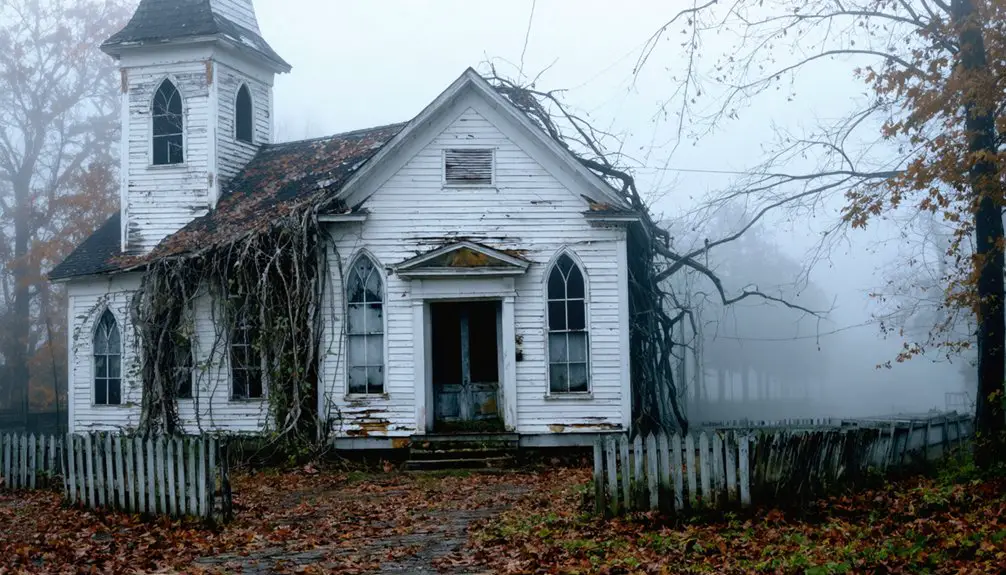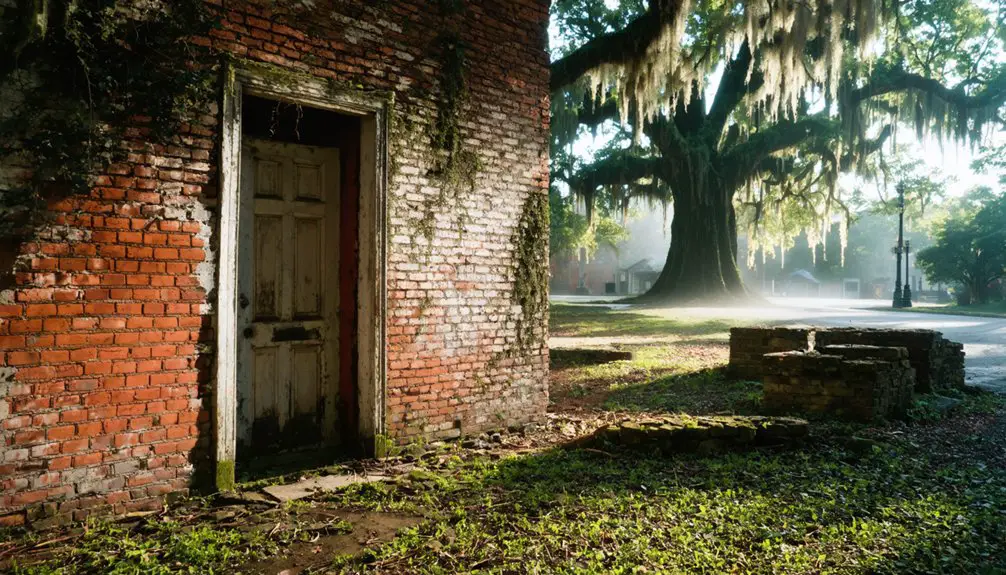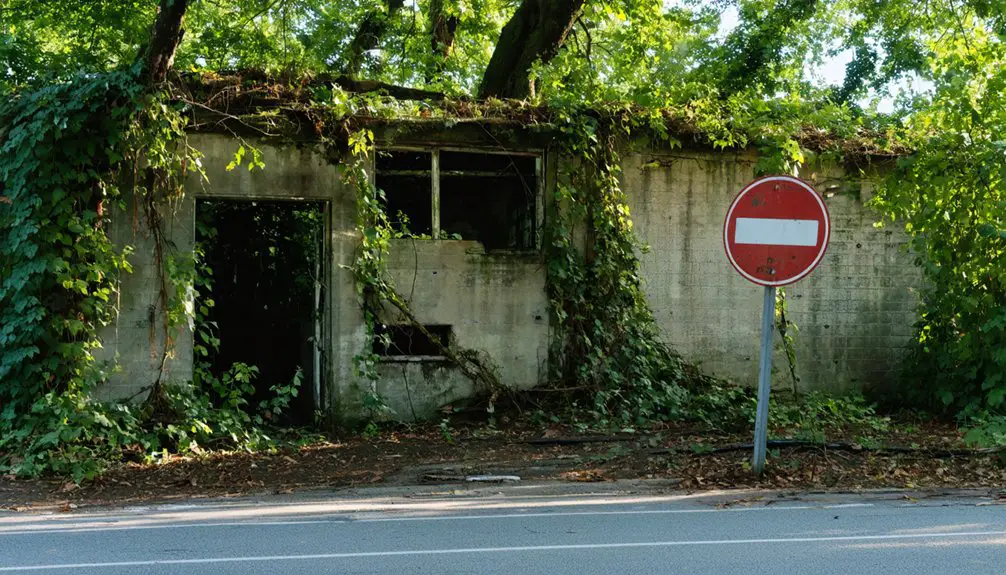You’ll find Westham’s ghost town roots in colonial Virginia, where it emerged as an essential trading post in 1750 along the James River Fall Line. The town flourished as a cargo transfer point where ships couldn’t navigate past dangerous rapids, leading to bustling warehouses and commercial activity. By 1930, urban development transformed Westham into a Richmond suburb, though archaeological sites and the historic Westham Station still hold clues to its prosperous past.
Key Takeaways
- Westham transformed from a bustling 1750s trading hub into a residential suburb of Richmond by 1930, losing its original town identity.
- The historic Westham Station, once vital for river-rail commerce, was abandoned in the 1990s and faces severe structural deterioration.
- The original town layout disappeared as urban development replaced historic infrastructure, preserving only the name in modern suburbia.
- Westham’s decline began when transportation shifted away from river trade, despite its strategic location at the James River Fall Line.
- Modern preservation challenges and limited funding have left few traces of the original trading settlement’s commercial infrastructure.
The Birth of a Colonial Trading Hub
While Virginia’s colonial settlements were expanding westward in the mid-18th century, Westham emerged as an important trading hub around 1750 on land originally owned by the William Randolph II family.
You’ll find its strategic location at the Fall Line of the James River particularly significant – this natural boundary marked where river navigation ceased upstream, making it perfect for colonial trade. Like the wetlands of Pevensey Levels today, the area was rich in natural resources and wildlife that supported the growing settlement. The settlement’s development was guided by privacy regulations that governed land ownership and trade practices.
Initially named “Beverley” after Beverley Randolph, the settlement quickly gained regional influence through support from prominent Virginians like Peter Jefferson, William Cabell, and Carter Braxton.
Life Along the James River Fall Line
You’ll find Westham’s strategic position along the James River Fall Line, where the river drops 80-100 feet, made it a natural colonial stopping point for ocean-going vessels.
As ships couldn’t navigate past the rapids, merchants established warehouses and trading posts where European goods were unloaded and tobacco was collected for export. Batteaux boats were used to navigate the challenging waters around the rapids.
The town’s location at this natural boundary transformed it into an essential commercial hub, where flatboats from upstream mining operations met with downstream cargo vessels, creating a bustling transfer point for colonial Virginia’s expanding trade network. In 1772, the House of Burgesses authorized the first canal construction project to help ships bypass these challenging falls.
Strategic River Settlement Location
Located precisely at the James River Fall Line, Westham emerged as a strategic settlement where the river’s natural boundary between Piedmont’s hard rocks and coastal plain sediments created impassable rapids.
You’ll find this geological division served as a natural stopping point, as river navigation couldn’t continue upstream beyond the falls. Tobacco cultivation fueled much of the trade through this settlement after 1612.
Recognizing this strategic advantage, prominent Virginians like Peter Randolph and Peter Jefferson established the town around 1750, transforming it into a crucial economic transshipment hub.
The site’s unique position enabled the development of ironworks and mills powered by the rapids, while warehouses facilitated trade between Piedmont farmers and coastal markets.
River Trade and Transport
The James River Fall Line‘s natural barriers fundamentally shaped early colonial trade patterns, forcing adaptation in shipping methods and infrastructure. These rapids marked the head of navigation for many vessels moving upriver.
Like other trading centers at falls, the area developed warehouses and commercial infrastructure to facilitate cargo transfers between different vessel types. You’d find that river navigation required different vessels on either side of these rapids – ocean-going ships below and smaller batteaux above. Transport logistics demanded careful planning, with merchants establishing warehouses to store goods during transfer.
- Tobacco and other exports moved downstream through Westham to Richmond
- Imported goods traveled upstream via smaller boats after transfer at Fall Line ports
- The James River and Kanawha Canal provided an essential bypass around the rapids
Colonial Commerce Hub Development
While the James River Fall Line shaped early colonial trade, Westham emerged as an essential commercial hub around 1750 on land owned by William Randolph II.
You’d find the 5,000-acre Westham Plantation evolving into a bustling center where tobacco, iron, and flour moved through strategic warehouses.
The plantation economy relied heavily on enslaved labor, with owners aiming to maintain 30 working enslaved persons to sustain operations.
Town planners ambitiously laid out 150 surveyed lots on the Randolph farmland, though their vision of urban growth would ultimately fade by 1800.
Early Transportation and Economic Growth
Situated strategically along the James River’s Fall Line, Westham emerged around 1750 as an essential transportation hub in Henrico County, Virginia.
Westham grew into a crucial 18th-century transit point where the James River’s rapids created natural transportation boundaries in colonial Virginia.
You’d find this frontier town bustling with activity as it served as a vital transfer point where rocky rapids prevented further upstream travel. The town’s transportation innovations shaped its economic sustainability through multiple phases of development. The historic building became Richmond’s Visitor Center for many decades until falling into disrepair.
- River traffic initially drove commerce, connecting inland markets to coastal regions
- Canal systems later enhanced trade volume between Westham and Richmond
- Railroad arrival in 1911 revolutionized the movement of goods and passengers
Your journey through early Westham would’ve revealed a dynamic economy built on moving resources like iron, agricultural products, and manufactured goods from Virginia’s Piedmont region to coastal markets. The C&O tracks became a crucial gateway to Richmond, transforming regional connectivity for over five decades.
The town’s multiple transportation modes kept commerce flowing despite geographic challenges.
Notable Families and Social Development
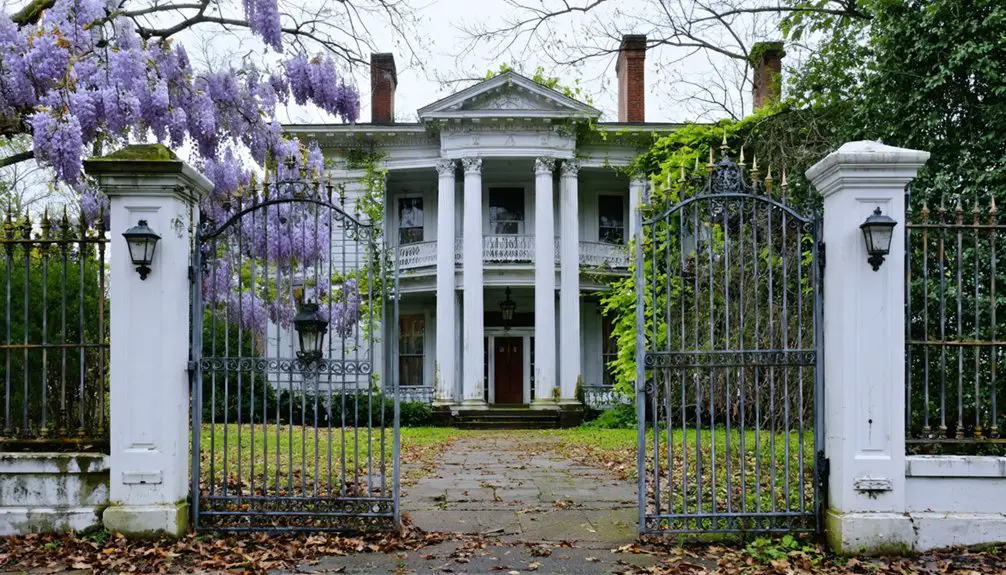
As prominent Virginia planter William Randolph II‘s land holdings transformed into a bustling town, Westham’s social fabric emerged through the interconnected lives of influential colonial families. Beverley Randolph initiated the town’s development, while his brother Peter later renamed it in his honor.
The social hierarchy included notable figures like Carter Braxton, a Declaration of Independence signer, and Joshua Fry, a respected cartographer.
While elite families strengthened community cohesion through marriage alliances and social institutions, the town’s economy relied heavily on enslaved labor. Henry Williams, enslaved by Benjamin W. Green, represents the often-overlooked individuals who were forcibly part of this system.
Churches, businesses, and communal services fostered connections among residents until Westham’s eventual absorption into Richmond’s expanding boundaries.
Archaeological Discoveries and Cultural Heritage
Recent archaeological excavations at Westham have revealed a complex tapestry of burial practices and cultural heritage spanning multiple centuries.
You’ll find evidence of both Native American and African American burial sites, with distinctive cultural rituals that tell the story of Virginia’s diverse past.
Archaeological surveys, using historical maps from 1901 and 1912, have identified significant graveyards adjacent to today’s University of Richmond campus.
- Death watch ceremonies included ritualistic singing and body preparation
- Multiple exhumations suggest relocated burial sites near the lake area
- Artifacts recovered include ceramics, tools, and structural remnants
The site’s strategic location along the fall-line attracted both Native American settlements and English colonists, creating rich archaeological layers.
The discoveries mirror findings at nearby Jamestown and Henricus, where similar excavation techniques have uncovered fort foundations and domestic structures.
The Rise and Fall of Westham Station
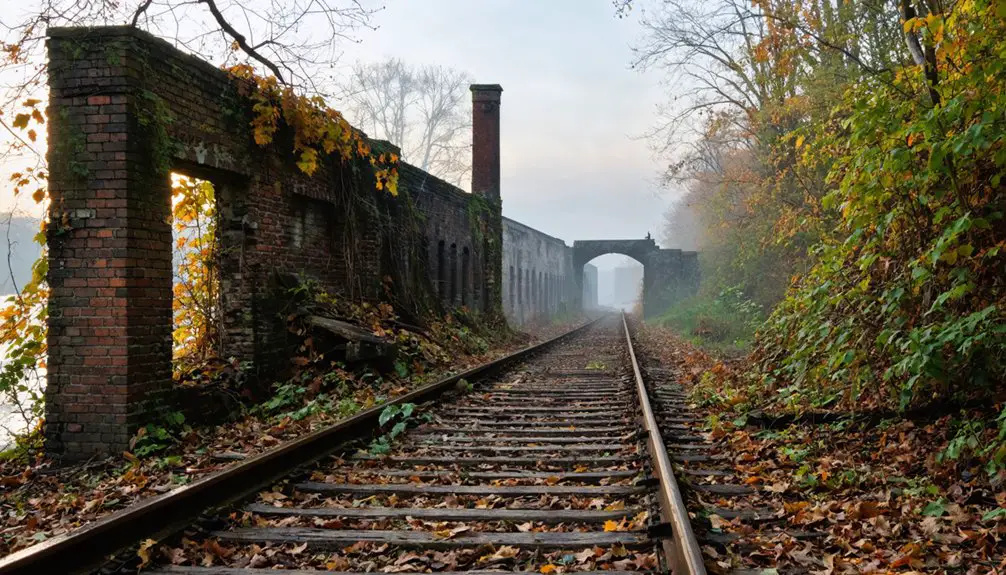
You’ll find Westham Station’s origins in the 1880s, when it emerged as an essential transport hub along the Richmond and Allegheny Railroad, serving both passenger travel and freight movement through central Virginia.
The station evolved into a community center, offering telegraph services and supporting local commerce until the mid-20th century.
After its relocation to Richmond in 1961, the historic structure served as a visitor center for decades but now faces significant preservation challenges, with its deteriorating roof and structural damage threatening its survival.
Historic Transport Hub
While Richmond’s industrial expansion gathered steam in the 1880s, Westham Station emerged as an essential transport nexus along the Richmond and Allegheny Railroad.
You’ll find this hub’s transportation evolution marked by its strategic position near the Fall Line, where river navigation ended and rail transport began. The station’s regional significance grew after the C&O Railway acquired it in the 1890s, connecting the Piedmont region to Richmond’s bustling markets.
- Served as a significant gateway for both passengers and freight entering Richmond
- Facilitated Revolutionary War logistics and commerce via James River trade routes
- Maintained telegraph operations and coal-heated facilities through the 1950s
The station’s prime location near Westham Bridge made it an important transfer point between river and rail freight, supporting the region’s industrial growth until the mid-20th century.
Railway Community Center
The 1911 construction of Westham Station marked a new chapter in Richmond’s railway history, expanding beyond its predecessor’s role as a transport hub.
You’d find the wooden structure serving both freight and passenger needs, while supporting local commerce throughout central Virginia for over five decades.
When civic volunteers and Jaycees relocated the station to Robin Hood Road in 1963, you could witness its transformation into Richmond’s official Visitor Center at Traveland.
This reimagining of railway heritage created a vibrant community engagement space, complete with locomotive displays, playgrounds, and green areas.
The station became your gateway to Richmond’s culture and history until the 1990s, when the Visitor Center’s closure led to the building’s abandonment.
Today, you’ll find this once-bustling community center deteriorating, awaiting preservation efforts to revive its historical significance.
Preservation Challenges Today
Since its abandonment in the 1990s, Westham Station has faced mounting preservation challenges that threaten its historic legacy.
You’ll find the 1911 structure suffering from severe roof damage and structural decline, while decades of exposure to weather and vandalism have accelerated its deterioration.
Despite its significance as a rare example of early 20th-century rail architecture, community activism remains surprisingly low.
- Limited funding strategies have hindered proper restoration efforts
- Urban development pressures conflict with preservation goals
- Lack of public awareness reduces advocacy opportunities
Without immediate intervention, you’re witnessing the potential loss of a critical piece of Central Virginia’s transportation history.
The station’s preservation requires substantial financial investment, which local governments and civic groups haven’t secured.
The challenge lies in balancing modern development needs while protecting this irreplaceable historical landmark.
From Thriving Town to Richmond Suburb
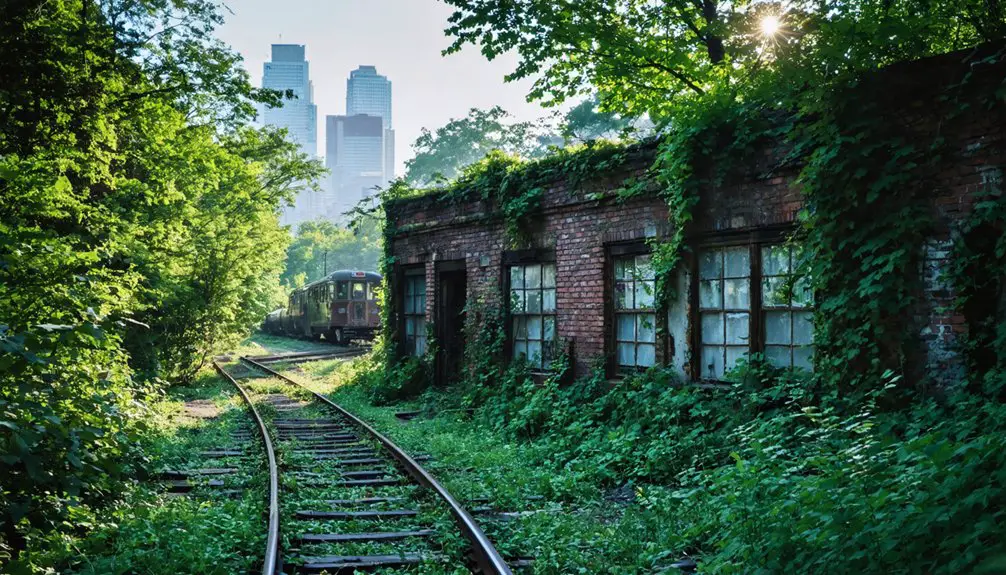
Originally established on William Randolph II’s plantation lands, Westham flourished as an important transportation hub and iron production center during the mid-18th century.
You’d find the town strategically positioned at the Fall Line of the James River, where it facilitated significant trade between the Piedmont region and Richmond.
After Benedict Arnold’s devastating raid in 1781 and subsequent economic decline, Westham’s independence gradually eroded.
By 1930, urban integration had transformed the once-bustling town into a residential suburb of Richmond.
The original town’s layout disappeared beneath new infrastructure, with Richmond Way replacing historic sites including burial grounds.
What was once a crucial independent community with its own foundry and canal system became fully absorbed into Richmond’s expanding metropolitan area, preserving only its name in the modern suburban neighborhood of Westham.
Preserving Westham’s Historical Legacy
As Richmond’s urban expansion threatens Westham’s remaining historical structures, preservation efforts have focused on two key landmarks: the 1911 Westham Train Station and the Granite Schoolhouse.
You’ll find these sites listed among Virginia’s 10 most endangered historic places for 2025, highlighting the pressing need for preservation initiatives.
The train station, which served as an essential transportation hub until the early 2000s, faces significant challenges:
- Rapid deterioration due to roof damage and general neglect
- Pressure from surrounding development projects
- Lack of clear ownership and preservation funding
Community involvement remains important for saving these landmarks.
With only 10% of historically listed endangered sites lost to demolition, you’ve got reason to be optimistic.
The upcoming Virginia 250th anniversary celebration offers a perfect opportunity to rally support and secure funding for these irreplaceable pieces of history.
Frequently Asked Questions
What Happened to the Original Buildings and Structures of Westham?
You’ll find most original buildings were lost to urbanization, though the train station was relocated in the 1960s for building preservation. Few historical artifacts remain as development replaced the town’s original structures.
Were There Any Major Fires or Natural Disasters in Westham’s History?
You won’t find records of major fire incidents or natural disaster impacts in Westham’s documented history. The deterioration you see today comes mainly from neglect and time’s natural progression.
What Indigenous Peoples Inhabited the Westham Area Before Colonial Settlement?
Like ancient sentinels of the land, the Siouan-speaking Monacan and Manahoac tribes inhabited your area, living west of the Fall Line, while the Powhatan Confederacy’s influence remained primarily in coastal regions.
Did Westham Have Its Own Local Government or Administrative System?
You’ll find Westham didn’t have its own local governance system. As an unincorporated town, its administrative history fell entirely under Henrico County’s jurisdiction until Richmond eventually absorbed the area.
What Businesses and Industries Operated in Westham Besides Transportation Services?
Like a bustling beehive, you’d find iron manufacturing powering Revolutionary War efforts, coal mining operations from nearby Chesterfield pits, general stores serving local needs, and farming practices supporting tobacco production.
References
- https://en.wikipedia.org/wiki/Westham
- https://belonging.richmond.edu/_common/pdfs/burying-ground-report.pdf
- https://www.wtvr.com/news/local-news/richmond-westham-train-station-april-4-2025
- https://minskysabandoned.com/2015/08/06/west-virginia-ghost-towns-part-2-thurmond/
- https://www.caseybarber.com/thurmond-wv/
- https://encyclopediavirginia.org/entries/richmond-during-the-colonial-period/
- https://buryinggroundmemorial.richmond.edu/history.html
- https://founders.archives.gov/documents/Jefferson/01-03-02-0203
- http://www.virginiaplaces.org/transportation/canalsjames.html
- http://www.virginiaplaces.org/regions/fallcolonial.html
